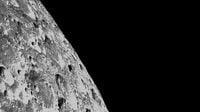When China’s Chang’e-6 spacecraft touched down on the far side of the moon in June 2024, it quietly set the stage for a scientific breakthrough that’s now turning heads across the world. For the first time, researchers have direct evidence that the moon’s mysterious far side—the hemisphere forever hidden from Earth’s gaze—harbors a much cooler interior than the side we see each night. What’s more, these findings are shedding new light on the moon’s dramatic “two-faced” personality, a puzzle that has long captivated planetary scientists.
The Chang’e-6 mission, operated by the China National Space Administration, made history by scooping up and drilling into the lunar surface within the South Pole–Aitken (SPA) basin, one of the largest and oldest impact craters in our solar system. After a careful journey home, the spacecraft delivered its precious cargo to Earth, landing in Inner Mongolia with the first-ever rock samples from the moon’s far side. These fragments, it turns out, hold secrets that reach deep into lunar history.
According to a study published on September 30, 2025, in Nature Geoscience, the Chang’e-6 samples formed roughly 2.8 billion years ago, crystallizing from molten rock about 60 miles beneath the lunar surface. Using a combination of computer simulations and satellite data, scientists determined that these farside rocks solidified at a temperature of about 1,100 degrees Celsius (2,012°F)—about 100 degrees Celsius cooler than samples collected from the moon’s nearside by NASA’s Apollo missions decades ago. That’s a difference you wouldn’t expect from two halves of the same small world.
“The near side and far side of the moon are very different at the surface and potentially in the interior. It is one of the great mysteries of the moon,” said Yang Li, a geoscientist and co-author of the study, in a statement cited by Space.com. “We call it the two-faced moon. A dramatic difference in temperature between the near and far side of the mantle has long been hypothesized, but our study provides the first evidence using real samples.”
The far side’s surface, as seen in images from NASA’s Orion spacecraft and other missions, is a rugged, crater-riddled landscape. Its crust is thicker, it’s more mountainous, and it’s pockmarked with far fewer of the dark, lava-filled basins—called maria—that dominate the nearside. The nearside, by contrast, is smoother and darker, its face largely covered by the volcanic plains that form the familiar “man in the moon.” These new findings suggest that the differences between the two hemispheres don’t stop at the surface. They extend deep into the moon’s interior, shaped by a complex interplay of heat, chemistry, and ancient cosmic events.
So what’s behind this surprising thermal divide? Researchers believe the answer lies in the moon’s recipe of heat-producing elements. The far side appears to have much less of the radioactive ingredients—uranium, thorium, potassium, phosphorus, and a group known as rare earth elements (collectively called KREEP)—that generate heat as they decay. These elements are more abundant on the nearside, likely keeping that hemisphere hotter and fueling the volcanic activity that once flooded its surface with dark basaltic lava.
“These findings take us a step closer to understanding the two faces of the moon,” said Xuelin Zhu, another co-author of the study, according to Space.com. “They show us that the differences between the near and far side are not only at the surface but go deep into the interior.”
Yet, the big question remains: how did the moon end up with such an uneven distribution of these elements? Scientists have floated several theories, each as intriguing as the next. One hypothesis suggests that a colossal asteroid slammed into the moon’s far side billions of years ago, redistributing the lunar interior and shifting heat-producing material toward the nearside. Another posits that the moon once had a smaller sibling—a companion moon that eventually merged with our own, enriching one hemisphere with radioactive elements. Some researchers even wonder if Earth’s powerful gravitational pull, which keeps the moon tidally locked so that one face is always turned toward us, played a role in this cosmic rearrangement.
“Understanding this lunar dichotomy is crucial for reconstructing its formation history,” Yang Li emphasized in comments to Reuters. “This knowledge also informs studies of other planets’ origins and evolution.” The moon, after all, formed alongside Earth about 4.5 billion years ago, and its volcanic history is a window into the early days of our solar system.
To reach their conclusions, the research team didn’t just rely on the lunar rocks themselves. They combined laboratory analyses of the samples with sophisticated computer models, reconstructing how hot the rock was when it solidified and estimating the temperature of its “parent rock”—the deep mantle material that melted into magma before cooling into the sample Chang’e-6 collected. Satellite data helped them map the distribution of elements across the lunar surface, giving a clearer picture of how heat may have moved through the moon over billions of years.
Earth’s gravitational pull, which keeps the moon’s rotation perfectly synced so that we always see the same face, adds another layer of complexity. Some scientists speculate that this tidal locking might have influenced how elements migrated inside the moon, perhaps contributing to the stark contrast between hemispheres.
For now, the findings don’t reveal the moon’s current internal temperatures. But researchers say the thermal divide likely persisted for billions of years, shaping the landscape we see today. The far side’s thick crust and mountainous terrain hint at a cooler, less volcanically active past, while the nearside’s smoother plains tell the story of a hotter, more dynamic history. And as scientists analyze the Chang’e-6 samples in greater detail, they hope to unravel more of the moon’s secrets—including clues about how planets and moons across the solar system evolve over time.
It’s a story that’s still unfolding, but one thing is clear: the moon’s two faces, so different yet forever bound together, are helping us piece together the grand cosmic puzzle of our own origins.




